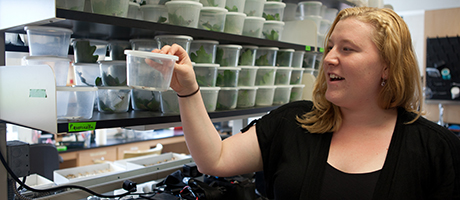Ten undergraduate and 16 graduate students from GW’s Department of Biology have received extra financial support this summer thanks to a generous gift from an alumnus.
A private foundation has been established by the estate of Wilbur V. (Bill) Harlan, A.A. ’35, B.S. ’35, through a generous $9 million bequest. The new foundation provides support exclusively to GW’s Department of Biological Sciences, with initial distributions totaling $1.35 million being used to support scholarships and create a greenhouse in GW’s new Science and Engineering Hall. Future distributions from the foundation will be split evenly between scholarships and general departmental support.
“We are deeply appreciative of the generous support provided to our Department of Biological Sciences through the Harlan Trust,” said Peg Barratt, dean of GW’s Columbian College of Arts and Sciences. “Funding scholarships and a state-of-the-art greenhouse to advance the science of life, in all its varied forms, is a remarkable legacy and a testament to Bill Harlan’s deep commitment to GW.”
The scholarships, which include research stipends and tuition assistance, are merit-based and will fund semester and summer research projects for undergraduate and graduate students as well as specialized workshops and courses.
Some of the projects that this year’s Harlan Scholars are conducting include examining how sea urchins battle bacteria, how cells move to heal wounds and the evolution of catfish in fresh and salt waters.
The foundation has also provided funds for a 3,600-square foot greenhouse to be built in GW’s Science and Engineering Hall. The world-class greenhouse facility, which will be named in honor of Mr. Harlan, will be used for teaching and research projects, with a focus on plant-herbivore interactions and the role of plants in developing a more sustainable economy.
Junior Ariel Michelle Stein has been studying catfish since she was a freshman in high school. The Harlan scholarship allowed her to continue her research this summer, which now focuses on catfish from Australia and New Guinea, with Guillermo Orti, the Louis Weintraub Associate Professor of Biology.
“I was extremely excited and honored to receive the Harlan Scholarship, especially since it was such a competitive applicant pool,” she said. “This scholarship gave me the opportunity to work with an amazing laboratory full of remarkable professors and researchers who have taught me so much in just a few short months.”
“I feel this type of student-professor relationship is extremely important in my major and will benefit me in the future,” she said.
A summer highlight for Ms. Stein has been her experience working as a researcher for the Smithsonian National Museum of Natural History, where she had access to the institution’s Museum Support Center in Maryland and the largest collection of fish in the world.
“These types of opportunities are what make being a biology major at GW so incredible,” she said. “I look forward to continuing my research as a Harlan Scholarship recipient.”
Junior Michelle Sliwinski is working with Associate Professor of Biology John Lill studying Lepidoptera, a large order of insects that include moths and butterflies. Her research focuses on the effects of forest fragmentation on the diversity of leaf-tying caterpillar species and on the arthropod community as a whole.
She said Dr. Lill encouraged her to apply for a Harlan scholarship, which now helps support her research and field work.
“I was thrilled when I learned that I had received the scholarship,” said Ms. Sliwinski. “I learned a great deal about valuable lab techniques in a Harlan workshop that will definitely benefit me in future lab courses, and my work in the field with Professor Lill and the other graduate students has been a lot of fun.”
Partnered with his commitment to GW and his life-long interest in science, Mr. Harlan’s strong belief in the power of education motivated his bequest to fund scholarships. A botany major at GW, Mr. Harlan served as a lab instructor at the university and later, in 1938, began a career teaching English in Kabul, Afghanistan at the advice of a former GW botany professor.
In World War II, Mr. Harlan served as an instructor and a medical officer in Asia. He was an agricultural specialist with the U.S. Department of Agriculture at experimental stations in Bolivia, Ecuador, Turkey and Honduras. After retiring, Mr. Harlan traveled the world and lived in Europe for 10 years, spending time in Spain, England and Ireland. In 2001, he published his memoirs, Looking Back at My Life. He passed away in 2006.


